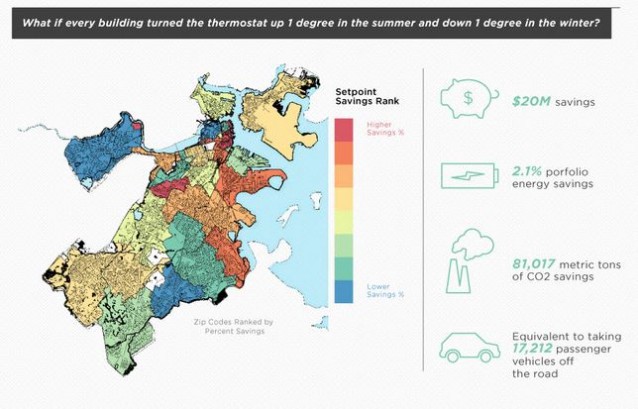Turning thermostats in Boston buildings up one degree in the summer and down one degree in the winter would save millions of dollars per year and result in significant energy savings, according to a new report.
The report, published by Retroficiency, a company aimed at helping buildings across the U.S. increase their energy efficiency, looked at more than 16,800 commercial buildings in Boston, a city with a goal to reduce its greenhouse gas emissions by 25 percent by 2020 and 80 percent by 2050. The report looked at a couple different ways Boston could save energy in its buildings, and charted the energy and monetary savings of each one.
If buildings turned up their thermostat one degree in the summer and down one degree in the winter, they would create a collective $20 million in energy savings each year, and would cut CO2 emissions by 81,017 metric tons — a reduction equivalent to removing 17,212 cars from the road. If all large hotels, retail buildings, and office buildings in the city installed advanced lighting controls — ie. controls that automatically turn lights off at certain times — the buildings would save $27 million and 81,368 metric tons of CO2. And if every office in the city adopted a schedule that included a half day every Friday in the summer, the buildings would save $2 million and 7,054 metric tons of CO2 — about the same as taking 1,499 cars off the road.

If all of these measures were put in place, they would get Boston about 24 percent closer to reaching its 2020 emissions reductions goal.
“These scenarios demonstrate that, while a city like Boston has made great strides in its efficiency efforts, significant savings opportunities can still be achieved,” the report states.
Mike Kaplan, VP of Marketing for Retroficiency, said in an email that savings from these actions would vary from city to city based on factors such as what types of buildings (offices, hospitals, etc.) are most common in the city and what sort of weather the city experiences. Still, he said, these energy-saving measures are a good step for a building in any city to take.
“Overall, reducing the set point one degree will always have a positive impact across a portfolio of buildings — the scale is determined by these outside factors,” Kaplan said. “This is one reason we’re conducting the Building Genome project, to show these cities, utilities and energy companies what’s possible on the commercial building energy efficiency front. There is huge potential in this market for both environmental and economic savings.”
Boston is the second city in Retroficiency’s Building Genome Project, which seeks to determine ways cities around the U.S. can save energy through tweaking the way their buildings use it. Retroficiency did an analysis of more than 30,000 buildings in New York City in April, and found that if the buildings turned their thermostat up one degree in the summer and down one degree in the winter, they would save $145 million annually. Measures to improve energy efficiency have been found to be an important part of combating climate change. An October study found that gains in energy efficiency in major countries over the past 10 years saved more energy than China consumed in 2011. Energy efficiency investments also save money and can result in major health benefits.
